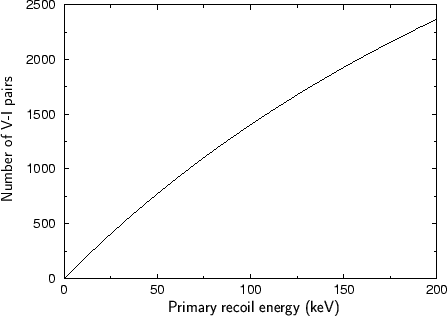 |
 |
In the Kinchin-Pease model the number of point defects generated by an implanted ion is derived analytically from the energy that is transfered from an ion to an atom of the target material. It is assumed that the number of point defects generated by a primary recoil is proportional to the energy transfered from the ion to the primary recoil. A primary recoil is a recoil generated by the collision of an implanted ion with a target atom, while secondary recoils are generated by recoils.
As already mentioned each primary recoil generates additional recoils and
thereby vacancy-interstitial pairs (Frenkel pairs). Norgett
et al. [60] proposed a formula to approximately calculate the number of Frenkel
pairs ![]() generated by a primary knock-on effect based on an
expression given by Kinchin and Pease [44].
generated by a primary knock-on effect based on an
expression given by Kinchin and Pease [44].
In contrast to the original Kinchin-Pease model this modified model considers also the electronic energy loss of the recoils. Fig. 3.11 show the number of generated vacancies and interstitials as a function of the energy of a primary silicon recoil.
Worth mentioning is that the modified Kinchin-Pease model is valid for energies of the primary recoil below
| (3.148) |
Furthermore this model does not give any information about the location of the vacancies and interstitials. Therefore it has to be assumed that all point defects are located in the vicinity of the position of the primary knock on.
![]()
![]()
![]()
![]() Previous: 3.3.5 Material Damage -
Up: 3.3.5 Material Damage -
Next: 3.3.5.2 Follow-Each-Recoil Method
Previous: 3.3.5 Material Damage -
Up: 3.3.5 Material Damage -
Next: 3.3.5.2 Follow-Each-Recoil Method